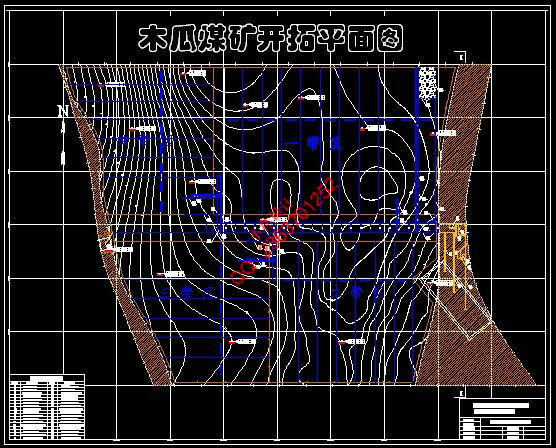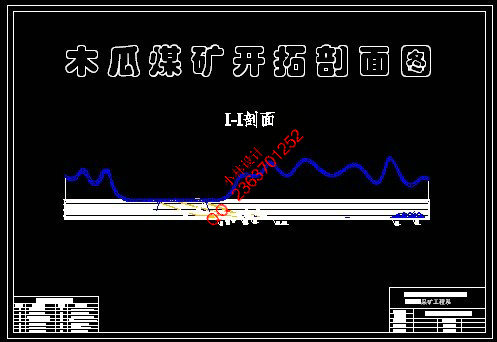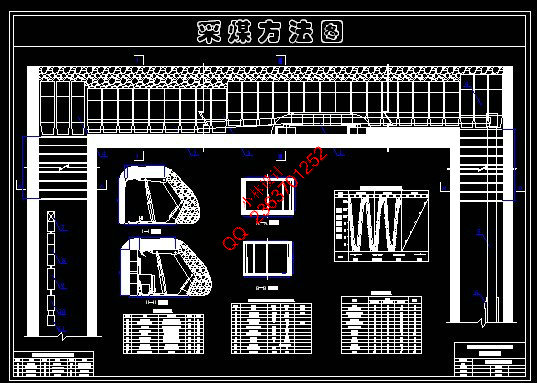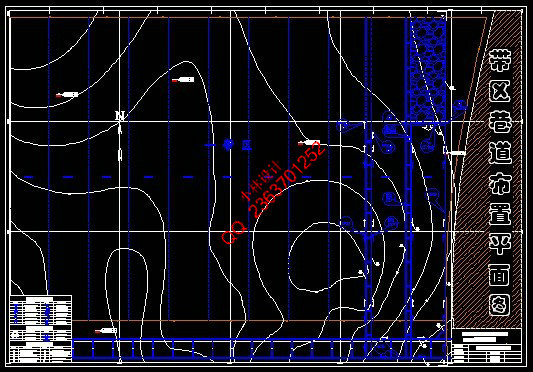|
设计描述:
文档包括:
Word版说明书1份,共149页,约58000字
外文翻译一份
CAD版本图纸,共5张
摘 要
本设计包括三个部分:一般部分、专题部分和翻译部分。
一般部分为木瓜煤矿1.5 新井设计。木瓜煤矿位于山西省方山县境内,交通便利。井田走向(东西)长约3.69 ,倾向(南北)长约3 ,井田总面积为10.32 。主采煤层为9号、10号煤,平均倾角为6 ,煤层平均总厚为9.13 。井田地质条件较为简单。
井田工业储量为14204 ,矿井可采储量10150 。矿井服务年限为52.1 ,涌水量不大,矿井正常涌水量为40 ,最大涌水量为66 。矿井瓦斯涌出量较低,为低瓦斯矿井。
井田为双斜井单水平开拓。大巷采用胶带运输机运煤,辅助运输采用无轨胶轮车设备。矿井通风方式为混合式通风。
矿井年工作日为330 ,工作制度为“三八”制。
一般部分共包括10章:1、矿区概述及井田地质特征;2、井田境界和储量;3、矿井工作制度及设计生产能力;4、井田开拓;5、准备方式-带区巷道布置;6、采煤方法;7、井下运输;8、矿井提升;9、矿井通风与安全技术;10、矿井基本技术经济指标。
专题部分题目是近距离煤层下煤层安全开采技术研究,主要是研究了下煤层的巷道布置。
翻译部分主要内容为关于煤矿用胶带输送机,英文题目为:Research of Fire Hazard Critical Guidelines of Mine Use Belt Conveyor and Automatic Fighting Fire System。
ABSTRACT
This design includes of three parts: the general part, special subject part and translated part.
The general part is a new design of Mugua mine. Mugua mine lines in West of Fangshan county in ShangXi province. The traffic of road and railway is very convenience to the mine. The run of the minefield is 3.69 ,the width is about 3 ,well farmland total area is 10.32 .The nine and ten is the main coal seam, and its dip angle is 6 degree. The thickness of the mine is about 9.13 in all. Geologic structure of coalfield is simple.
The proved reserves of the minefield are 142.04 million tons,and the recoverable reserves are 101.50 million tons. The designed productive capacity is 1.5 million tons percent year, and the service life of the mine is 52.1 years. The normal flow of the mine is 40 percent hour and the max flow of the mine is 66 percent hour. The mineral well gas gushes is lower, It is a low gas mineral well.
The mine is a single level in an inclined well to expand. Te central laneway use Belt Conveyor to transit coal, mining trucks are used for accessorial transportation in te roadway.Te ventilation mode of this mine is composite form.
The working system “three-eight” is used in the Mugua mine. It produced 330 d/a.
This design includes ten chapters: 1.An outline of the mine field geology; 2.Boundary and the reserves of mine; 3.The service life and working system of mine; 4.development engineering of coalfield; 5.The layout of panels; 6. The method used in coal mining; 7. Transportation of the underground; 8.The lifting of the mine; 9. The ventilation and the safety operation of the mine; 10.The basic economic and technical norms.
The topic of special subject parts is Technology Research Aboat Safe Working In The Lower Seam Of Close Coal Seams.It mainly includes the roadway’s form in the lower coal seam.
Translation part is aboat mine use belt conveyor.It’s english topic is Research of Fire Hazard Critical Guidelines of Mine Use Belt Conveyor and Automatic Fighting Fire System.
目 录
一般部分
1 矿井概况与地质特征 1
1.1 矿井概况 1
1.1.1地理位置与交通 1
1.1.2 地形地貌及水系 1
1.1.3 气象及地震 1
1.1.4 矿区电源 2
1.1.5 地区经济状况 2
1.2 井田地质特征 2
1.2.1 井田地质概况 2
1.2.2 地层 2
1.2.3 褶皱及断层 4
1.2.4 水文地质特征 4
1.3 煤层特征 6
1.3.1 煤层 6
1.3.2 煤质及煤的用途 7
1.3.2 煤层开采技术条件 8
2 井田境界和储量 10
2.1井田境界 10
2.2 矿井工业储量 10
2.2.1 储量计算基础 10
2.2.2 矿井工业储量计算 10
2.3 矿井可采储量 12
2.3.1井田边界保护煤柱 12
2.3.2工业广场保护煤柱 12
2.3.3断层和井筒保护煤柱 13
2.3.4 矿井可采储量 14
3 矿井工作制度、设计生产能力及服务年限 15
3.1 矿井工作制度 15
3.2 矿井设计生产能力及服务年限 15
3.2.1 确定依据 15
3.2.2 矿井设计生产能力 15
3.2.3 矿井服务年限 15
3.2.4 井型校核 16
4 井田开拓 18
4.1井田开拓的基本问题 18
4.1.1确定井筒形式、数目、位置及坐标 18
4.1.2工业场地的位置 20
4.1.3开采水平的确定及带区的划分 20
4.1.4主要开拓巷道 21
4.1.5开拓方案比较 21
4.2矿井基本巷道 28
4.2.1井筒 28
4.2.2井底车场 32
4.2.3大巷 35
5 准备方式—带区准备方式 38
5.1煤层地质特征 38
5.1.1带区位置 38
5.1.2 带区煤层特征 38
5.1.3 煤层顶底板岩石构造情况 38
5.1.4 水文地质 38
5.1.5 地质构造 38
5.2 带区巷道布置及生产系统 38
5.2.1 带区准备方式的确定 38
5.2.2 带区巷道布置 39
5.2.3 带区生产系统 41
5.2.4 带区内巷道掘进方法 42
5.2.5 带区生产能力及采出率 43
5.3 带区车场选型设计 44
6 采煤方法 46
6.1采煤工艺方式 46
6.1.1 带区煤层特征及地质条件 46
6.1.2 确定采煤工艺方式 46
6.1.3 回采工作面参数 47
6.1.4 采煤工作面破煤、装煤方式 48
6.1.5 采煤工作面支护方式 50
6.1.6端头支护及超前支护方式 51
6.1.7各工艺过程注意事项 53
6.1.8回采工作面正规循环作业 54
6.2回采巷道布置 55
6.2.1回采巷道布置方式 55
6.2.2回采巷道支护参数 56
7 井下运输 59
7.1 概述 59
7.1.1 井下运输原始数据 59
7.1.2 井下运输系统 59
7.2 煤炭运输方式和设备的选择 60
7.2.1 煤炭运输方式的选择 60
7.2.2 带区煤炭运输设备选型及验算 61
7.2.3 运输大巷设备选择 63
7.3 辅助运输方式和设备选择 63
7.3.1 辅助运输方式选择 63
7.3.2 辅助运输设备选择 63
8 矿井提升 66
8.1 矿井提升概述 66
8.2 主副井提升 66
8.2.1 主井提升 66
8.2.1 副斜井提升设备选型 67
8.2.3 井上下人员运送 69
9 矿井通风与安全 70
9.1 矿井概况、开拓方式及开采方法 70
9.1.1 矿井地质概况 70
9.1.2 开拓方式 70
9.1.3 开采方法 70
9.1.4 变电所、充电硐室、火药库 70
9.1.5 工作制、人数 70
9.2 矿井通风系统的确定 70
9.2.1 矿井通风系统的基本要求 71
9.2.2 矿井通风方式的选择 71
9.2.3 矿井主要通风机工作方式的选择 72
9.2.4 带区通风系统的要求 73
9.2.5 工作面通风方式的选择 73
9.3 矿井风量计算 74
9.3.1 工作面所需风量的计算 75
9.3.2 备用面需风量的计算 76
9.3.3 掘进工作面需风量 76
9.3.4 硐室需风量 77
9.3.5 其它巷道所需风量 77
9.3.6 矿井总风量计算 78
9.3.7 风量分配 78
9.4 矿井通风阻力计算 79
9.4.2 矿井通风阻力计算 84
9.4.3 矿井通风总阻力计算 85
9.4.4矿井总风阻和等积孔计算 85
9.5选择矿井通风设备 86
9.5.1选择主要通风机 86
9.5.2电动机选型 89
9.6安全灾害的预防措施 89
9.6.1预防瓦斯和煤尘爆炸的措施 89
9.6.2预防井下火灾的措施 90
9.6.3防水措施 90
10 设计矿井基本技术经济指标 92
专题部分
近距离煤层下煤层安全开采技术研究 94
参考文献 114
翻译部分
英文原文 115
中文译文 127
致谢 137
| 









